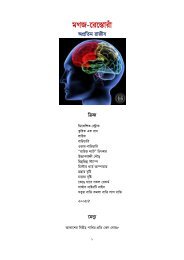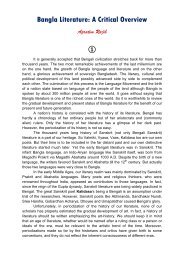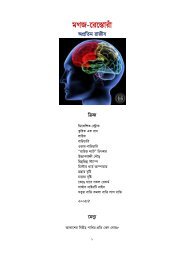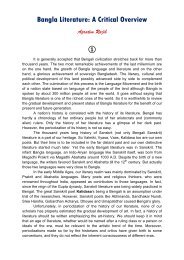BLiterature-Apratim
You also want an ePaper? Increase the reach of your titles
YUMPU automatically turns print PDFs into web optimized ePapers that Google loves.
2<br />
With the gradual change of civilization and culture, human outlook goes<br />
through continuous alteration. As a result, a writer who is once recognized as great,<br />
may not be so forever. A critic’s judgment of literature is often consciously and<br />
sometimes unconsciously based on the general views of his own time. So my words<br />
also are not a superman’s gospel. The readers are entreated to keep it in mind.<br />
After a careful scrutiny, I have prepared the following list –<br />
The Buddhist Age (8 th -12 th Centuries)<br />
The Turkic Age (13 th Century)<br />
The Sultanate (14 th -15 th Centuries)<br />
The Vaishnava Age or The Age of Chaitanya (16 th Century)<br />
The Mogul Age (17 th Century)<br />
The Nawabi Age (18 th Century)<br />
The Scholastic Age (1801-’58)<br />
The Heroic Age (1858-’90)<br />
The Romantic Age or The Age of Tagore (1890-1936)<br />
The High Modern Age (1936-’60)<br />
The Liberation (1960-’90)<br />
The Postmodern Age (Since 1990)<br />
2<br />
Historical Development<br />
The Buddhist Age (8 th -12 th Centuries)<br />
Buddhism is one of the greatest philosophies of the antiquity. Buddhism,<br />
unlike other religions, emphasizes the development of self rather than worship of an<br />
imaginary god. It teaches a person to free oneself of evil and harmful instincts and to<br />
attain the blissful state of Nirvana. It is a truly humanistic religion which shows the<br />
mankind the way of having a high order of humanity.<br />
The first glimmer of our unique national literature was actually seen around<br />
the 8 th century AD when Bengal came under the control of the Buddhist Pal dynasty.<br />
Then people’s self-consciousness of their regional identity was arising and its sign<br />
was in the growth of their own culture.<br />
Buddhism in Bengal had remarkable distinctiveness from other Buddhist<br />
countries. People here worshipped several Buddhist gods and goddesses who were<br />
believed to have attained Nirvana. This faith was slowly merging with other Indian<br />
religions including Hinduism. In Bengal, Tantric and Sahajiya Buddhism developed<br />
among common people, which later resulted in flowering of Vaishnava and Baul<br />
mysticisms.

















